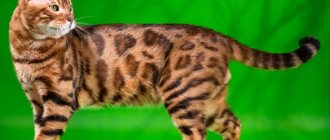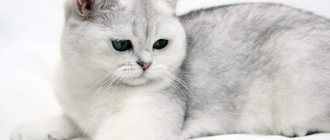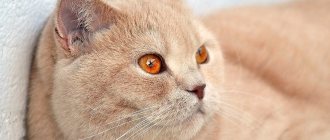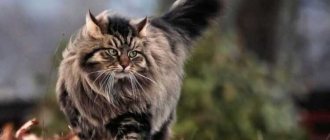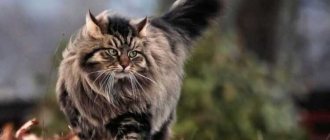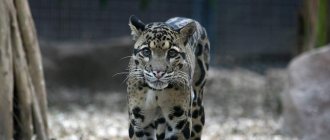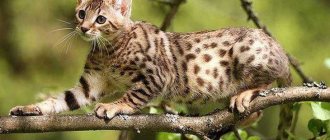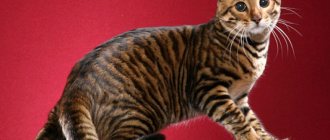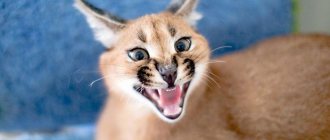History of the species
The history of jungle cats begins when the ancient Egyptians domesticated a subspecies of the cat called Felis chaus. This is a type of African cat, the image of which is preserved on many famous figurines from the times of Ancient Egypt.
The ancient Egyptians domesticated African cats from nearby territories.
These were excellent hunters who brought prey to their masters and replaced dogs as guards. Beginning in the 18th century, attempts began to crossbreed the jungle cat with other representatives of cat breeds in order to breed a pet that could retain a developed hunting instinct combined with an amiable character.
IMPORTANT: Wikipedia indicates that the “reed cat” species was first described by the imperial naturalist Johann Anton Güldenstedt in 1776.
Currently, the wild reed cat lives in more than 20 countries around the world, and the largest representatives of the subspecies have settled in the Caucasus. Reed cats or “swamp lynxes” prefer to live next to people, which often causes discontent among the latter: the wild habits of these animals can deprive the farm of a significant number of small livestock.
The jungle cat, although not ferocious, is still a wild and unpredictable beast
IMPORTANT: the jungle cat is listed in the Red Book of Russia and is protected by law.
The jungle cat is used in breeding, bringing into the world exotic offspring. One of these original breeds is the Chausie - a mixture of the jungle and Abyssinian cat, which was bred and officially registered in 1995.
The photo shows a representative of the Chausie breed
In its pure form, the total number of representatives of the subspecies falls annually, which is associated with continuous deforestation and the death of animals in forest fires, which often burn in the steppe regions of their habitat.
Cat house, or swamp lynx
House (or chaus), swamp lynx, jungle cat - different names for one animal, very ancient, original and interesting. He has a lot in common with a person - both good and, unfortunately, tragic.
The jungle cat is a long-time neighbor of man
History of the species
This intelligent, strong animal attracted the close attention of the ancient Egyptians, famous connoisseurs of feline nature, several thousand years ago. They domesticated, as far as possible, the local African subspecies Felis chaus, and since then the proud outline of this animal has been preserved in the famous cat figurines from Ancient Egypt
You recognize - yes, it’s him, cat house
Active attempts to hybridize the marsh lynx began much later, from the end of the eighteenth century - felinologists were looking for options for home keeping that would successfully combine the best qualities of the jungle cat with at least a more or less docile character.
Habitat
A wide strip of the habitat of the jungle cat runs from North Africa through the entire south of Eurasia, right up to Western China. Nine subspecies of the marsh cat freely settled in these territories, which can differ significantly in both color and size.
Despite all the differences in its subspecies, the house cat always remains smart, brave and moderately brutal
Video: where and how the jungle cat lives
Under guard
Unlike most other wild cats, the jungle cat willingly settles close to humans, but both sides are more likely to lose than to gain from such proximity. The marsh cat is not at all averse to hunting domestic animals and does it very successfully. In response, people declare a brutal war on her.
Man is displacing the Hausa from their permanent habitats
However, it is not only the conflict of food interests that seriously threatens the very existence of this wild cat species. Irreparable damage to livestock is caused by ordinary human economic activities: deforestation, drainage of large floodplain areas. Many animals die in “man-made” steppe and forest fires; For many, an abnormally cold winter turns into a tragedy, when it is impossible to either stay warm or find food.
Fur coats made from jungle cat fur, despite the ban, are widely offered on the Internet
Despite its relatively large habitat, the number of the species is constantly falling. This threatens to disrupt the ecological balance, because in the regions where they live, the marsh lynx copes excellently with the work of a natural orderly and successfully regulates the number of small rodents.
Appearance and features
At first glance, the jungle cat is not much different from an ordinary pet, but this is a misconception. The appearance and character of animals have differences that are most clearly determined by the description of the breed.
Cats of this subspecies have many similarities with other felines.
Dimensions and weight of jungle cats
The size and weight of the animal indicate that the jungle cat is somewhat larger than domestic felines. The body length of a jungle cat can reach 50-95 cm, and its weight does not exceed 15 kg.
Anatomical features
This subspecies of felines has a very developed body structure, especially the muscles that are always in good shape, as well as strong and long paws, thanks to which the animal moves deftly across any terrain. They move quickly and gracefully across the surface, jump high and skillfully climb trees.
This type of cat has pronounced yellow or green eyes.
The animal's tail has a black tip, but is not particularly long or thick. The ears are decorated with graceful tassels, and their height, in some cases, can reach eight centimeters.
Color
The animal's coat is short, with a thick undercoat, which has the unique natural property of quickly removing dirt and strong water-repellent ability. In summer, jungle cats “dress up” with shorter fur, and in winter their coats become fluffier. Often the color of the animal is a gray-red camouflage.
The color of the jungle cat helps it camouflage and hunt in natural conditions
Description
The body length of the marsh lynx varies between 70-120 cm, and the height at the withers is 35-38 cm. Weight ranges from 4 to 16 kg. Males are larger and heavier than females. Throughout its entire range, there is significant variation in mass. For example, in western Israel, they weigh 43% more than in eastern India. This is likely due to increased competition between different cat species in the east.
The jungle cat is large, slender, with long legs and elongated, close-set, rounded ears that have characteristic small black tufts at the tips. It has a long, thin muzzle, with distinctive white markings above and below the eyes, as well as dark spots in front of the eyes, near the nose.
Reddish, sandy-brown or yellowish-gray coat color is usually plain, without any spots or patterns. However, the ends of the guard hairs are black and create a mottled appearance. House may also have multiple stripes on his legs. The neck is pale cream, with occasional dark or light stripes, and the belly is lighter than the rest of the body. There are several narrow black rings near the tip of the tail. The marsh lynx's tail is smaller than that of a domestic cat, and occupies about a third of the body length, including the head.
Juveniles, from birth to sexual maturity, have stripes and spots. Adult cats may sometimes retain some of these markings, usually in the form of spots or dark stripes on the front and hind legs.
Based primarily on external morphological differences, marsh lynxes have been divided into 10 subspecies:
- F. c. nilotica (Egypt);
- F. c. chaus (Caucasus);
- F. c. furax (Israel and Iraq);
- F. c. oxiana (along the Syr Darya and Amu Darya rivers);
- F. c. prateri (Thar Desert in the Indo-Pakistan region);
- F. c. affinis (Himalayan region);
- F. c. kutas (Northern India);
- F. c. valballala (South India);
- F. c. kelaarti (Sri Lanka);
- F.c. fulvidina (Southeast Asia).
Features of character and lifestyle
The jungle cat is a wild predator whose habitat has taught it to live and survive in harsh natural conditions. The character of the animal is also formed here, which is inherited by its direct descendants by genotype.
Determination, pride and intelligence, heightened by the survival instinct - all this forms the basis of the jungle cat’s character. Such a pet will not put up with an encroachment on his personal space and will not obediently tolerate an attitude that seems unacceptable to him. The wild nature has forever programmed in these animals a pronounced desire for independence. The jungle cat will defend itself and its territory to the last.
Jungle cats are especially fierce in protecting their offspring.
IMPORTANT: jungle cats can act very domestically; in particular, they meow and purr in exactly the same way as regular domestic cats.
One of the most pronounced traits in the character of the jungle cat is a love of solitude and a nocturnal lifestyle, which is why the cat sleeps a lot during the day and is awake at night. For rest, the animal chooses a warm and safe place for itself, since it does not perceive cold well and is not at all adapted to sub-zero temperatures. Most of the time, jungle cats lurk in dense thickets, where they hide from stronger competitors (wolves, large dogs and leopards).
With the onset of darkness, they go out hunting, skillfully pursue prey in long runs and deft silent attacks, are not afraid of water, are excellent at catching fish and generally have extraordinary hunting skills.
Chausie's appearance
Chausie F1
The appearance of the representatives of the breed is worthy of praise from cat lovers from all over the world. Chausie - moderately muscular animals with a proportionally built body - are very similar to their distant ancestors. Despite inbreeding with the Abyssinians, the cats managed to maintain impressive dimensions: a weight of 14-15 kg and a height at the withers of up to 40 cm.
The Chausie is classified as a medium-sized short-haired breed. They are distinguished by pronounced sexual dimorphism: males are 15-20% larger than females.
Head and skull
The cat's head is distinguished by the shape of a wedge or, as it is also called, an elongated triangle. Moderately elongated, but looks small in comparison with the body of the Chausie. It has graceful outlines, no angularity. The forehead is flat and wide, the occipital protuberance is slightly pronounced. The skull is rounded.
Muzzle
The neat and small muzzle of the animal is composed of smooth lines. Stop – the transition from the nose to the forehead is quite sharp. The bend of the high cheekbones in the direction of the cheekbones is also noticeable. The nose and chin of the Chausie form a straight line. It is noteworthy that the width of the bridge of the nose depends on the gender of the animal: in cats it is narrower. The lobe is convex.
Ears
Chausie F2
Large ears with a wide base are set high, almost on the top of the chausie's head. The distance between the “triangles” is significant. The reverse side of the ears is decorated with false “eyes” - spots that the cat inherited from its distant ancestors from Egypt. The tips of the ears are pointed and crowned with small tassels. The presence of the latter is welcome, but the absence is not regarded as a breed defect.
Eyes
The almond-shaped eyes of the Chausie are set quite close, slightly slanted. Amber or deep yellow pigmentation is preferred. Variation in the shade of the iris within the yellow-green palette is acceptable.
Neck
Chausie cat face
The thick and short neck of the Chausie does not look awkward and allows the animal to maintain harmonious body proportions.
Frame
Chausie kitten
The tightly built and heavy body of the cat has superbly developed muscles. As Chausie owners are used to joke about their pets: “It’s like an Abyssinian on anabolic steroids!” The animal's chest is quite deep and wide, which contrasts with the cat's narrow shoulders and pelvis. The back is straight, the underline is moderately tucked.
Tail
The Chausie's straight and flexible tail is notable for its lack of kinks. Wide at the base and quite mobile, making up ¾ of the body length.
Limbs
The animal's legs provide powerful propulsion, so don't be surprised if your pet can easily jump onto the highest shelf in the closet. The muscles are well developed. The Chausie's paws are large, but despite this, they look compact. Fingers are not tightly gathered.
Coat
The short fur fits tightly to the body of the animal. Elastic hairs have a healthy shine. The undercoat is developed. The guard hair is ticked (unevenly colored) in at least two places.
Color
The Chausie breed standard provides for three main colors:
Chausie kitten F2 black and silver color
- black. The cat's fur is evenly colored, there are no marks;
- black ticked tabby. The hairs are colored with two or three stripes. The undercoat has a golden-red hue. The points are located on the tail and inside of the Chausie's paws; on the body they are unacceptable. The chin and eye rims are highlighted;
- black and silver ticked tabby. The guard hair has two or three ticking stripes of silver and black colors. The tips are always painted in a dark shade. Pronounced tabby points are undesirable.
Possible defects
A Chausie breed defect is any deviation from the standard. Among the main ones are:
- small, close-set ears;
- atypical pigmentation of the iris;
- poorly filled chest;
- clearly rounded head shape;
- excessively elongated neck;
- weak stop;
- hunchback.
Animals are disqualified for the following reasons:
- short tail (less than ¾ body length);
- white points on the body;
- amputated claws;
- congenital deafness;
- undescended testicles.
Is it possible to keep a jungle cat at home?
At first glance, it may seem that such an idea is nonsense and it is impossible to train a wild animal. This is partly true, but still cases of keeping a jungle cat at home exist and are successfully practiced with one condition: the future pet must get used to living together with a person from the first months of life. Otherwise, the training enterprise is doomed to failure and it will be almost impossible to curb the wild nature of the animal.
The jungle cat can become a pet and an exotic decoration for the home, but this will require a lot of time and effort.
Many people, in pursuit of the exotic, forget that some breeds are bred and evolved directly for domestic conditions, but not all types of cats are able to adapt to life in captivity. The jungle cat is one of those closest relatives of cats that was created by nature for a wild habitat. He cautiously and warily welcomes human society, and will perceive any attempts to limit freedom as a threat to his own safety. It is for this reason that jungle cats are purchased as one-month-old kittens, subject to patient and long-term care for the animal. Only in this case is there a real chance of raising a pet that will peacefully and obediently coexist next to a person.
IMPORTANT: we should not forget that surrounded by human care and the best living conditions, the jungle cat forever remains a wild predator.
How to buy a Housie kitten
Becoming the owner of a Hausie kitten is quite difficult. There are several problems along this path:
- Officially registered nurseries are located mostly in the USA and a little in France. There is unconfirmed information about a Russian nursery breeding hybrids, including the Hausie.
- Due to the difficulty of breeding, the cost of kittens is high. First generation F1 hybrids can cost from five hundred thousand rubles to one million. The cost of an F5 class kitten is about one hundred thousand, this is the lowest price for a Hausie on the official market.
Nurseries prefer to give away kittens at three months of age
When choosing a kitten when purchasing, pay attention to the following:
- Appearance that meets breed standards: color, muzzle shape, location of black spots. In a Hausie of any color, the tip of the tail and the edges of the ears are always painted black, and a “necklace” of black spots can be seen on the neck; babies belonging to the F1 subgroup, in addition, have black spots on the back of their ears.
- External signs of good health: no discharge from the eyes and ears, clean coat without bald spots or scratches, sharp claws without damage.
- Kitten behavior: he should be active and friendly. Manifestation of passivity, drowsiness, and aggressiveness is undesirable, although a long journey can negatively affect the baby’s condition.
- It is advisable to see the parents of the little Hausi. If this is not possible, then familiarize yourself with the photographs and documents on them.
- When communicating with the nursery employee accompanying the baby, try to get more information about the nursery and the peculiarities of keeping a Hausie. The level of competence of the breeder's representative will help determine the cattery category.
- When purchasing a kitten, the following documents must be presented:
- a purchase and sale agreement, which includes an indication of castration or sterilization and the opportunity to take part in exhibitions (these points affect the cost of the baby);
- passport with his pedigree, name and date of birth;
- veterinary documents indicating the date of vaccinations.
Features of care
The jungle cat is by no means hardened by a “sofa” lifestyle, therefore it has excellent health and physical indicators that are the envy of all domestic cats. The nuances of the conditions of detention include several points:
- Rabies vaccinations are at the top of the list of jungle cat care obligations;
- Walking in the fresh air is an obligatory part of the animal’s lifestyle; the jungle cat gets used to a leash and harness without much persuasion;
The jungle cat needs frequent walks and exercise.
- Keeping such a cat in a cramped environment is a very bad idea: the animal needs space with a variety of games and entertainment;
- It is important to support your pet’s hunting instinct so that it does not get bored and does not begin to show unreasonable aggression: sometimes you can buy a live mouse or fish at a pet store, which the cat will happily hunt;
- Mixed breeds of this type are kept in comfortable enclosures equipped for natural conditions;
- Bathing for such an animal is a true pleasure, so it is advisable to open the swimming season for it at least once every two months;
Jungle cats love to swim and hunt in water
- At home, jungle cats are prone to weight gain; for this reason, the pet’s diet should be strictly controlled;
- It is necessary to comb out the jungle cat during the seasonal molting period; a furminator copes best with this task;
Diet
What to feed a hedgehog at home?
The menu of jungle cats in the wild is very diverse, including: birds, reptiles, insects, fish and small mammals. They prefer to hunt at dusk or at night.
When going hunting, patient cats can wait in ambush for hours until the curious face of a small rodent appears from a hole. Birds are waylaid, hiding in the thickets, and then caught on takeoff. Reed cats often go fishing using cunning techniques.
They carefully hit the surface with their paw, imitating the movement of insects, and then snatch out an unwary fish with their claws or dive headlong after it. If there are bird nests along the way, the house is sure to feast on eggs or young chicks
What to feed a domestic jungle cat
It is recommended to feed an adult animal once a day. The daily menu should consist of approximately 200 g of meat. It could be lean beef, veal, a couple of live mice or one rat. Chickens and quails are also provided as live food. Fresh or live fish is offered once a week
An important component of the content are fasting days. Once a week for 24 hours, the predator goes on a starvation diet.
Such measures are necessary to maintain the health and normal weight of the cat. Mandatory supplements include vitamins and fresh herbs. Kittens up to one year old eat twice a day, the diet is supplemented with dairy and fermented milk products, calcium supplements and other microelements.
Wild cats do not digest foods rich in fiber well, so you should not experiment with cereals and vegetables. Dry industrial foods should also be avoided.
Even holistic and super premium diets contain grains, and their protein composition cannot satisfy the needs of a wild cat and maintain the microflora of the digestive tract in the required balance.
What and how to feed
Dry food, even the best premium quality, will not please a jungle cat. His diet should consist of natural products: lean lean meat, plant foods, vitamin supplements necessary to maintain health, and unprocessed live food (with skin, blood, feathers).
Feeding your pet periodically should remind him of wild hunting in the field.
Reproduction and care of kittens
The mating season begins in February-March and can last until April. This time passes tensely, with brutal fights between rivals and loud screams. At this time, cats are especially aggressive, so it is better for humans or other animals not to come into contact with them. The conquered female accepts the courtship of the gentleman and begins to prepare for the birth of offspring. The reed lynx finds a suitable place for shelter and insulates it with its own fur.
The offspring are born in May (pregnancy lasts 2 months), and their number is always different - from 2 to 6 individuals, rarely 10 kittens are born at once. In a large litter there are fewer females than males. The kitten's weight is 60-100 g, the cubs are born blind, opening their eyes in the second week of life. The cat feeds them with milk for up to 3 months, and from two months they are gradually accustomed to regular food. The stages of growth are accelerated, while the father does not leave the family and take care of him throughout the entire period of growing up of the kittens. From 5 months they no longer need parental care.
Reproduction
The mating season for jungle cats begins at the end of winter and beginning of spring: males make their “serious” intentions known with a loud sound, thereby attracting females for mating. After this, pregnancy begins, which lasts no more than two months.
Newborn kittens grow quite quickly and soon gain their own independence.
Typically, no more than five kittens are born in one litter and, characteristically, both parents take care of them in the future. Already at the age of one month, babies turn into independent animals, they can eat and even move without assistance. By six months, they turn into skilled hunters and are finally separated from their parents.
Reproduction of reed lynxes and caring for offspring
At the end of February and beginning of March, male jungle cats begin to make loud calls - it’s time to give birth to new kittens, so you need to attract a female. At this time, you should not try to take a closer look at the animal, as it becomes aggressive and can direct its rage at a person.
After 53-66 days of pregnancy, 2-5 blind cubs are born. The female prepares a den for them, insulating it with dry grass and her fur. Usually the lair is located in the most difficult places for enemies to reach. Males often remain with the newly formed family for some time.
A marsh kitten becomes independent at six months, but does not leave its mother for a long time.
According to statistics, males are born in greater numbers.
Pros and cons of this cat breed
Buying a jungle cat is a serious and controversial step with an unpredictable outcome. You can get a domestic cat that will be quite habituated and friendly to its owner, but it is also possible that the slightest flaws in the educational process will give vent to the animal’s wild temperament. In the latter case, he will be aggressive, poorly trained and reluctant to listen to the demands of his patron. In general, the idea of taming such a wild animal is a conscious step that will require a lot of patience and constant effort on the part of the owner.
Gaining the respect of the jungle cat is a task for real enthusiasts
- The owner, who has managed to replace the kitten’s parents, has every chance of becoming its closest and most trusted guide to the outside world;
- Many breeders are attracted by the originality of the animal, whose wild essence clearly contrasts with the habits of a domestic cat acquired during the process of upbringing;
- All educational measures are applied promptly at an early age: reed kittens are very smart and quickly understand the essence of the requirements;
- A jungle cat will be able to accept human authority, but only on condition that the owner takes into account his natural characteristics;
Hausie coat color and texture
Wool changes its structure significantly depending on the season. In summer it becomes tougher and looser. By winter, chausies become pubescent. The coat becomes thicker and softer. The undercoat becomes denser.
Read here Abyssinian cat - character, description of the breed, diseases and maintenance features (90 photos)
The color completely matches the color of wild relatives. It can fluctuate a bit, but generally has sandy gray undertones.
Chausies may have a tendency to have a monochromatic coat, or exhibit spotting in the form of black spots and sometimes even stripes.
Buy a jungle cat kitten
Buying a jungle cat kitten is not an easy task. Most often, hybrid breeds are bred and sold, usually Chausie cats and other exotic breeds.
When choosing a kitten, you should pay attention to its cleanliness and grooming.
There are specialized nurseries that provide purebred representatives of the subspecies. Sometimes jungle cats are found at elite exhibitions. The kitten will cost at least $4000-5000. You can take a pet into your home from the moment it turns one month old. It is not recommended to purchase an older kitten: there is a possibility that the animal will not become accustomed to living conditions at home.
Diseases and health
House is not susceptible to diseases at the genetic level. He has hereditary wonderful health. But when kept in an enclosure, some problems are possible.
Possible diseases
As a rule, cats do not get sick . Occasionally, deviations are possible that are associated with low mobility and improper feeding. This could be joint disease, digestive system problems or obesity. To prevent them, you need to pay a lot of attention to walks with your pet and balance your diet. Jungle cats can suffer from viral diseases, which are prevented by vaccinations given to kittens.
Breeding and organizing a chausie nursery
Breeding Chausie is allowed only to people with a felinologist diploma and who understand all the nuances of the breed. Therefore, before taking on this difficult task, you need to attend felinological courses and consult with professionals in this field. It would also be a good idea to spend some time breeding Abyssinian cats, since breeding Chausie cats is allowed only in professional nurseries with responsible breeders.
Breeding Chausie has several disadvantages:
- Firstly, cats of this breed are extremely expensive. In order to buy a pair for breeding, you will have to shell out at least half a million rubles, and to purchase a jungle cat, with which it is best to start breeding Chausie, you will have to shell out at least eight hundred thousand.
- Secondly, this is a very risky business, since the breeder faces many difficulties: infertility and mutations in kittens, inbreeding and many others.
- Thirdly, this business is designed for a very narrow category of people who can afford to spend 200,000 rubles or more on a cat.
But if you have sufficient funds, knowledge and experience and are not afraid of difficulties, then it is quite possible to try. But remember: cats must be purchased only from a specialized nursery with all licenses.
The Chausie breeder will have to work hard to get a cat that fully meets the standard.
Mating
For a novice breeder, the best choice would be an F1 generation cat. Breeding chausie involves many difficulties and nuances:
- Chausie cats up to the third generation are born infertile. Therefore, if you want to buy a couple of studs, then you need to take an F1 female and an Abyssinian cat.
- When you have already gained experience, you can also buy a reed kitten, always a male, since a wild female will not let a domestic cat near her. It should be crossed with an Abyssinian cat. A jungle cat may not agree to a proposed mate, so you may have to go through several females.
- The F2 female is also bred to an Abyssinian cat.
- Make sure your cats are blood type compatible. Cats have only two groups: A and B. Cats A and cats B are compatible with any partner, cats B are mated only with males B, males A are mated only with females A.
First generation Chausies love to hunt
Pregnancy
Some features of pregnancy during breeding should also be taken into account:
- The pregnancy of an Abyssinian cat from a jungle cat will last about 67–70 days, and she will bring two or three kittens. Moreover, some of them may not meet the standard and look more like an Abyssinian cat than a wild cat.
- A female Chausie F1 and F2 will give birth to about 3-4 kittens, which may also not meet the standard.
- Chausie males cannot have offspring until the third generation, so the boy can be sold under the F1 label if he is the son of a jungle cat and an Abyssinian cat; F2, if he is the son of an F1 female and an Abyssinian cat; F3, if he is the son of a Chausie F2 and an Abyssinian cat.
- Only Chausie females that fully comply with the standard are allowed to be selected for further breeding.
As you can see, breeding chausie is a very difficult matter. Only people who have the necessary knowledge and are ready to devote all their time and even their lives to chausie can achieve success.
Chausie needs an owner who can devote a lot of time to them
Note to the breeder
Before you start breeding Chausie, you need to obtain permission to breed Chausie and register the nursery.
- The breed is recognized only by TICA. Therefore, the nursery must be registered there.
- Each cat, both Abyssinian and Chausie, must have a breeding rating of at least “excellent” in the open category or a title certificate. You can get them at the exhibition.
- Each cat must have a confirmed pedigree.
- For each kitten, a birth certificate and a breeding sheet are issued, which is assigned a four-digit number. If you have a felinologist diploma, you can do this yourself.
- Chausies receive the same vaccinations as regular cats. Kittens receive a veterinary passport from 3 months.
